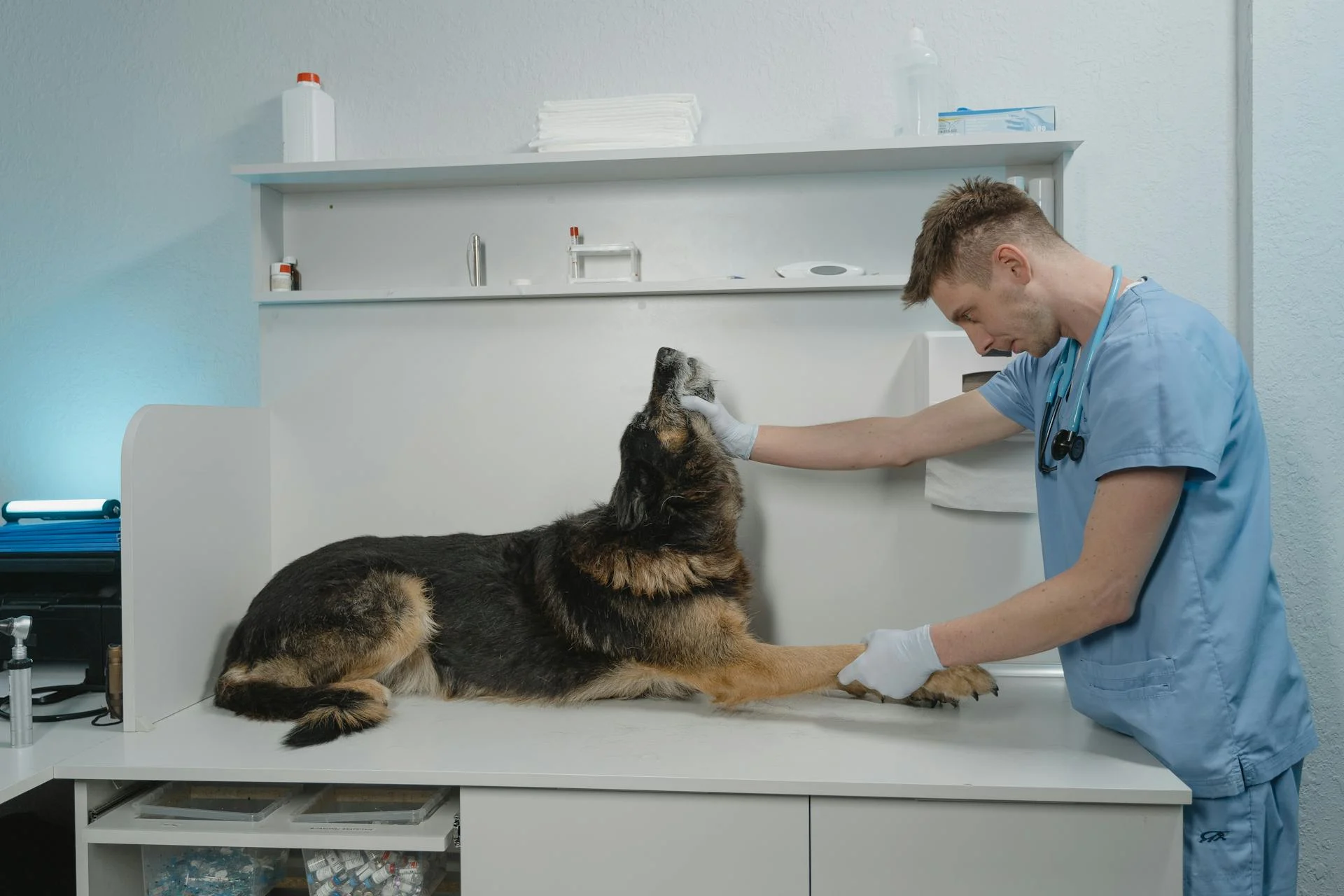
Canine distemper is a serious and highly contagious viral disease that affects dogs worldwide. It's essential to understand the disease and its outcomes to take appropriate precautions.
The disease is caused by the canine distemper virus (CDV), which attacks the dog's respiratory, gastrointestinal, and nervous systems. This virus is highly contagious and can be spread through direct contact with an infected dog's saliva, mucus, or other bodily fluids.
Symptoms of canine distemper can vary depending on the severity of the infection, but common signs include fever, vomiting, diarrhea, and a thick, yellow or green discharge from the eyes and nose. In severe cases, dogs may experience seizures, paralysis, and even death.
Canine distemper is usually diagnosed through a combination of physical examination, medical history, and laboratory tests, including blood tests and a PCR (polymerase chain reaction) test to detect the presence of the virus.
On a similar theme: Autoimmune Disease in German Shepherds
What Is Canine Distemper?
Canine distemper is a highly contagious virus that affects multiple species, including coyotes, wolves, and domestic dogs.
This virus targets the respiratory, digestive, and nervous systems of infected animals, making it a serious condition that needs immediate treatment.
Dogs can experience symptoms similar to a common cold, such as runny noses, coughing, fevers, and nasal discharge.
However, unlike a cold, canine distemper can also affect the stomach and eyes, and create disturbances in the nerves, resulting in twitches, convulsions, or seizures.
Young dogs between 3 to 6 months old are most susceptible to the virus, but it can infect dogs of any age.
Even vaccinated dogs can sometimes get infected, which is why it's essential to take precautions and get regular check-ups.
Worth a look: Dog Cold vs Kennel Cough
Clinical Presentation
Canine distemper is a serious disease that can be tricky to diagnose. Clinical signs of the infection can vary widely, making it hard to pinpoint.
Dogs with partial immunity may develop subclinical infections, where they shed the virus but don't show outward signs of illness. This can make it difficult to identify infected dogs.
Broaden your view: Signs Diabetes in Dogs
Common clinical signs of canine distemper include upper respiratory signs like eye or nose discharge, coughing, and sneezing. Vomiting, diarrhea, lethargy, and decreased appetite are also common.
More severe signs may be seen in puppies, and can include respiratory, gastrointestinal, and neurologic signs. Neurologic signs can include twitching or seizures, which are highly suggestive of CDV infection.
Here are some common clinical signs of canine distemper:
- Upper respiratory signs (eye or nose discharge, coughing, sneezing)
- Vomiting
- Diarrhea
- Lethargy
- Decreased appetite
- Neck/back pain or stiffness
- Twitching or seizures
In some cases, dogs may also experience fever, low energy, coughing, difficulty breathing, pneumonia, vision impairment, skin rash, and behavioral changes.
Transmission and Prevention
Canine distemper is a highly contagious disease that can spread quickly among dogs. It's shed in all body secretions of acutely infected animals.
Direct contact between infected dogs and susceptible dogs is the most common way the virus is transmitted. Aerosol transmission via airborne respiratory droplets, such as those emitted from coughing or sneezing, is also a major route of transmission.
Infected dogs can also transmit the virus through fomites like hands, feet, equipment, or contaminated surfaces. This is why good hygiene and thorough cleaning are essential in preventing the spread of the disease.
You might enjoy: What Is Canine Lupus
To prevent canine distemper, vaccination is the most effective way. The core vaccine should be given to dogs living in homes starting at 6-8 weeks of age, and repeated every 3-4 weeks until 16-20 weeks of age.
Here's a summary of the recommended vaccination schedule:
Infected dogs must be identified and isolated from other dogs to prevent further spread of the virus. Sanitation practices, such as good hygiene and thorough cleaning, can also help prevent the spread of canine distemper.
Causes of Dogs
Causes of Canine Distemper in Dogs can be a real concern for pet owners. The canine distemper virus (CDV) is responsible for this disease and can be spread through airborne droplets from an infected dog who coughs, sneezes, or leaves behind nasal or eye discharge.
Infected dogs can shed the virus for months after the initial infection, making public areas that house multiple dogs, such as boarders or shelters, high-risk areas for transmission.
For your interest: Canine Distemper Infection
Direct contact with an infected dog or wildlife can also spread the disease, as can exposure to contaminated food bowls, water bowls, toys, bedding, and other equipment.
Puppies under the age of 4 months and unvaccinated puppies and dogs are particularly susceptible to canine distemper.
The virus can be transmitted through the placenta from mother to unborn puppies, making pregnant dogs a high-risk group.
Here are some common ways canine distemper can be spread:
- Direct contact with an infected dog or wildlife
- Airborne droplets from the coughing and sneezing of an infected animal
- Exposure to contaminated food bowls, water bowls, toys, bedding, and other equipment
- From mother to unborn puppies through placenta
Transmission, Prevention
CDV is shed in all body secretions of acutely infected animals and can be transmitted through direct contact or airborne respiratory droplets.
The most effective way to prevent CDV is through vaccination, which should start at 6-8 weeks of age and be repeated every 3-4 weeks until 16-20 weeks of age.
Infected dogs must be identified and isolated from other dogs to prevent further spread of the virus, and caretakers should wear disposable PPE when interacting with the infected dog or cleaning their space.
You might enjoy: How to Work Out Dog Years
Most household disinfectants easily kill the virus, but dogs shed it through their bodily secretions for about one month, or sometimes up to 3 months.
Dogs that recover from natural infection have lifelong immunity to CDV, but revaccination every three years is still recommended in dogs who have recovered.
The virus can be transmitted through direct contact with infected dogs or other bodily fluids, such as saliva, urine or feces.
Here's a summary of the CDV vaccination schedule:
Dogs that are older than 16 weeks of age should receive two doses of vaccine three to four weeks apart and a revaccination at one year.
Population Considerations
When considering treatment for a dog with CDV, it's essential to examine the risk of contagion to other animals.
Shelters must consider how a long stay in isolation during treatment impacts an animal's welfare.
The individual animal's prognosis and welfare should be taken into account in all cases where treatment is being considered.
Shelters must ensure appropriate housing and care to maintain behavioral well-being in animals undergoing treatment.
If shelter resources cannot provide effective treatment and isolation, humane euthanasia should be considered in confirmed cases of CDV.
Recommended read: Lick Granuloma Dog Treatment
Diagnosis and Treatment
Diagnosis of canine distemper can be challenging, but a combination of clinical signs and laboratory testing can help arrive at a diagnosis. A veterinarian will typically perform a physical exam and may run urine, blood, or blood marrow tests to determine the cause of symptoms.
A PCR test is a common diagnostic tool, and a quantitative PCR is considered the current test of choice. This test detects the presence of the virus's genetic material, and can be used to confirm an infection and determine if a dog is still infectious to other dogs.
Collecting samples from dogs early in the course of infection, before starting antibiotics, is crucial for accurate test results. A complete necropsy with sample collection is also recommended if a dog dies or is euthanized, as postmortem testing can be the most efficient and reliable means to definitively diagnose CDV.
Here are the key considerations for collecting and submitting samples for respiratory pathogen PCR testing:
- Collect samples from dogs exhibiting clinical signs of disease as early in the course of infection as possible and before starting antibiotics.
- Follow a proper sample collection technique to ensure accurate test results.
- Select a PCR panel that includes quantitative distemper results to determine the amount of virus detected.
Diagnosis
Diagnosis of canine distemper can be a challenge, but there are several tests that can help determine if your dog has the disease.
A PCR (polymerase chain reaction) test is a common and effective way to diagnose CDV. This test detects the virus's genetic material in nasal, deep pharyngeal, and conjunctival swabs.
Collecting samples from dogs early in the course of infection and before starting antibiotics is crucial for accurate test results.
A veterinarian familiar with the shelter population should interpret PCR test results, as positive results can be difficult to interpret due to potential false positives from recent vaccination.
A complete necropsy with sample collection is the most efficient and reliable means to definitively diagnose CDV in an individual animal or population.
A PCR test can confirm an infection and determine if recovered dogs are likely to be still infectious to other dogs.
Quantitative PCR provides valuable information about the amount of virus detected, also known as viral load, which can help determine if a positive result is related to recent vaccination.
See what others are reading: How to Help Dogs with Skin Allergies

Blood antibody levels, also called serology, can indicate if an exposed dog is likely immune to infection.
High antibody levels paired with a negative PCR result suggest that a dog is likely immune.
Veterinarians may recommend blood work or chest X-rays to assess overall health and investigate contributing or secondary infections.
Here are some key considerations for collecting and submitting samples for respiratory pathogen PCR testing:
- Collect samples from dogs exhibiting clinical signs of disease as early in the course of infection as possible and before starting antibiotics.
- Follow a proper sample collection technique to ensure accurate test results.
- Consider a PCR panel that includes quantitative distemper results to provide information about the amount of virus detected.
Takeaways
There's no cure for canine distemper, so treatment is largely supportive. This means focusing on relieving symptoms and helping your dog feel more comfortable.
Puppies under 20 weeks old and unvaccinated dogs are particularly susceptible to infection, making them more vulnerable to the virus.
Clinical signs of CDV can be highly variable and may mimic other infections and diseases, making it difficult to diagnose. This is why it's essential to work closely with a veterinarian to determine the best course of action.
Here are some key takeaways to keep in mind:
- Puppies less than 20 weeks of age are especially susceptible to infection.
- Unvaccinated dogs are more vulnerable to the virus.
- Clinical signs of CDV can mimic other infections and diseases.
- There are no medications for CDV, so treatment is largely supportive.
Frequently Asked Questions
What are the first signs of distemper in dogs?
The first signs of distemper in dogs include discharge from the eyes and nose, fever, and lethargy, which can progress to coughing, vomiting, and diarrhea. If you suspect your dog has distemper, seek veterinary attention immediately to prevent further complications.
What can be mistaken for distemper?
Kennel cough and canine distemper can have similar respiratory symptoms, while vomiting and diarrhea may be mistaken for canine parvovirus, coronavirus, or other infections
What is the gold standard test for distemper in dogs?
The gold standard test for measuring distemper antibodies in dogs is virus neutralization, a highly accurate method for detecting immunity against Canine Distemper Virus (CDV). This test is widely regarded as the most reliable indicator of a dog's protection against distemper.
Sources
- https://www.aspcapro.org/resource/canine-distemper-virus
- https://www.vet.cornell.edu/departments-centers-and-institutes/riney-canine-health-center/canine-health-information/canine-distemper-virus
- https://www.ksvdl.org/resources/news/diagnostic_insights/march2016/Canine.html
- https://healthtopics.vetmed.ucdavis.edu/health-topics/canine-distemper
- https://wagwalking.com/condition/canine-distemper
Featured Images: pexels.com


